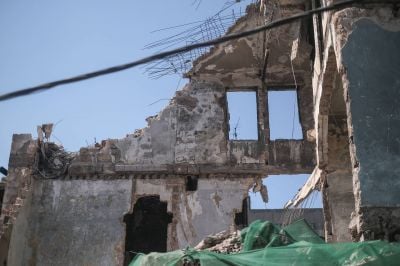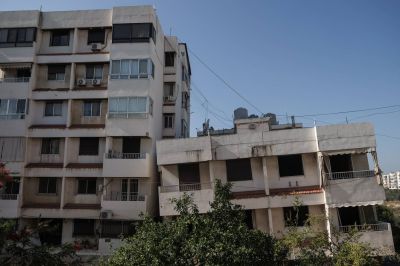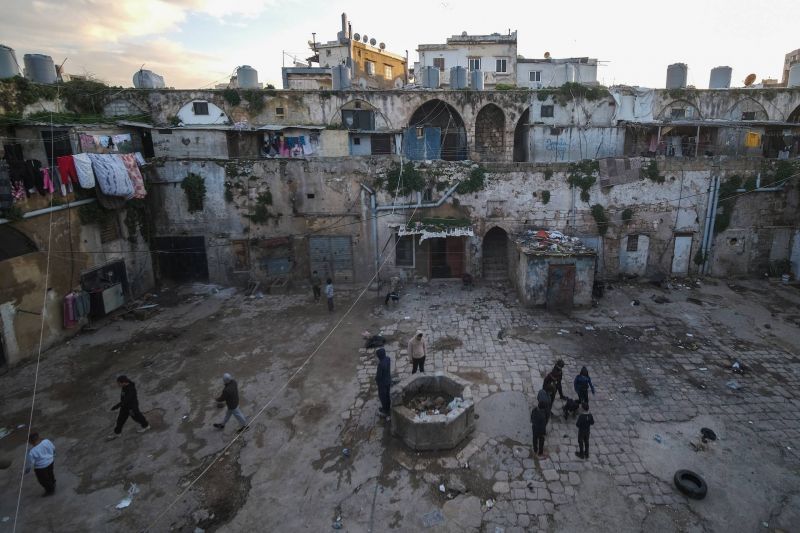
Khan al-Tamthili in Tripoli's Mina district is home to dozens of families and faced damage during the Feb. 6, 2023 earthquake. Feb. 9, 2023. (Credit: João Sousa/L'Orient Today/File photo)
TRIPOLI — For a year, Moustapha Jlaylati has been sleeping alone in his apartment in Tripoli’s Bab al-Tabbaneh neighborhood, without his wife and two daughters.
It all happened with the earthquake.
One year ago, on Feb. 6, 2023, a massive 7.8-magnitude quake reverberated near Gaziantep, Turkey, killing nearly 60,000 people across southern Turkey and northern Syria.
It also shook ground across the region, including in Lebanon’s Tripoli, where residents tell L’Orient Today they were violently awoken early that morning to their floors swaying beneath them.
“We felt it — the building swerved back and forth twice,” Jlaylati recalls.
Concerned about cracks in their own home that appeared after the quake, his wife and daughters now live with his in-laws. He says he’s not at ease leaving the house unattended and burdening his extended family.
Ascending to his third-floor apartment, which his brother purchased for him, the 44-year-old points at a collapsed ceiling and the multiple fissures etched upon the walls of the building's staircase. One apartment along the way has children’s shoes stationed out in front of its door — a sign there are still families living there despite the danger.
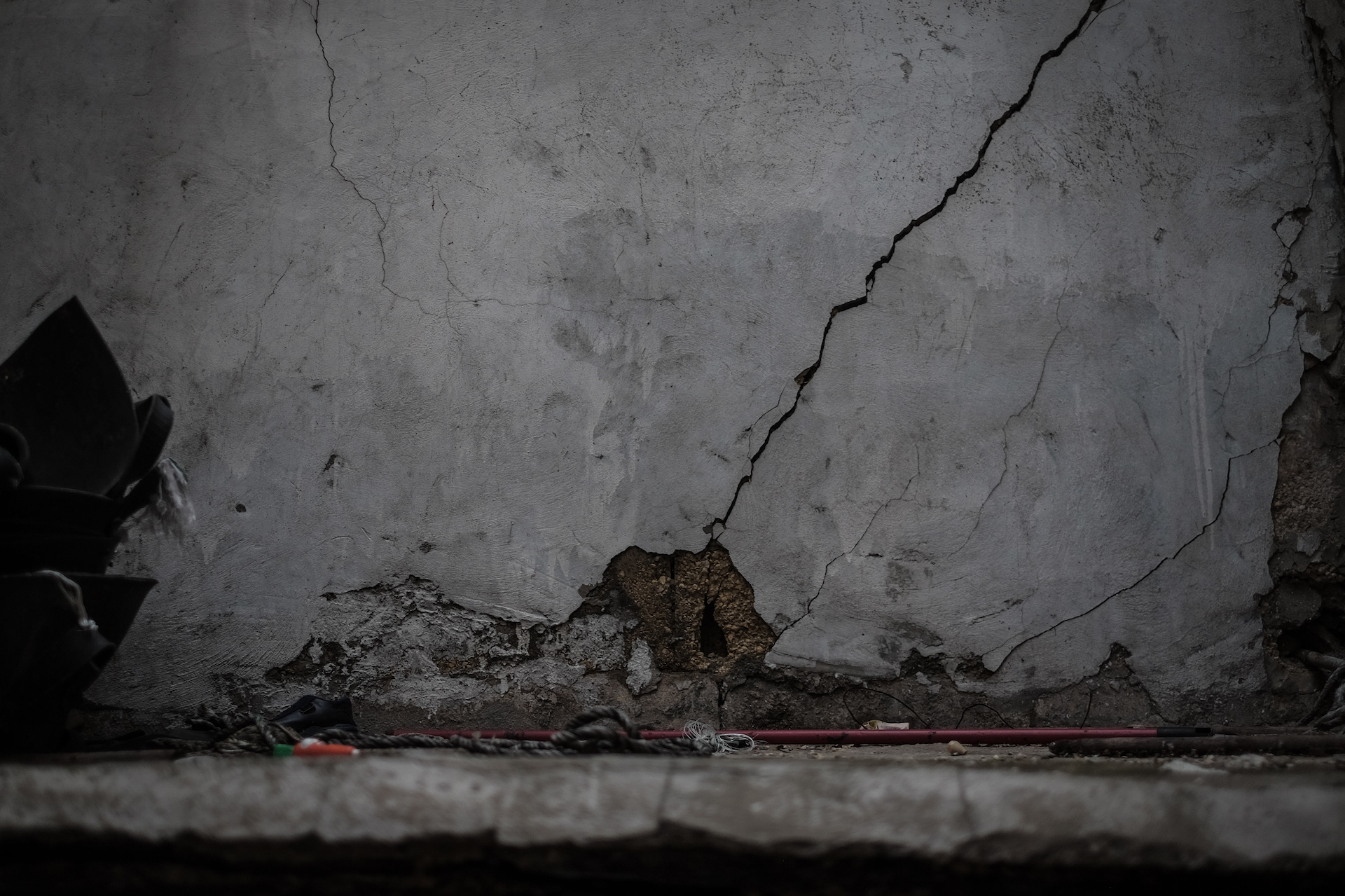 A cracked wall in Tripoli. Feb. 9, 2023. (Credit: João Sousa/L'Orient Today/File photo)
A cracked wall in Tripoli. Feb. 9, 2023. (Credit: João Sousa/L'Orient Today/File photo)
After last year’s quake, “neighbors started warning us that the building is at risk of collapse,” Jlaylati says. In response, Jlaylati and his family sought refuge first in Tripoli’s Mahmoud Bek Mosque and later in the recently UNESCO-listed Rachid Karami exhibition park.
In the months since then, he and other Tripoli residents tell L’Orient Today they’ve been left to their own devices to deal with earthquake damages that have only compounded existing structural concerns.
The Lebanese Association of Properties (LPA) claimed in October that there were 16,000-18,000 buildings at risk of collapse in Lebanon, stressed by climate change, improper drainage and other factors.
Camille Hashem, a representative from the Order of Engineers and Architects (OEA), tells L’Orient Today there are “at least” 4,000 buildings at risk of collapse in Tripoli — though that number is from a 2017 study. Today, he says, the real number of at-risk buildings is likely higher.
“Every year the buildings get older and older, so every year the number will increase by hundreds,” Hashem says. That includes homes and schools.
Family homes in disrepair
Not far away from Jlaylati, in Tripoli’s Mina district by the sea, is the Ottoman-era Khan al-Tamthili, once a hotel of sorts for wandering traders. Today it is home to about 50 households of informal residents, says 52-year-old resident Dalia Hammoul. She lives in one of the khan’s makeshift apartments with her husband and three children, one of whom works as a fisherman.
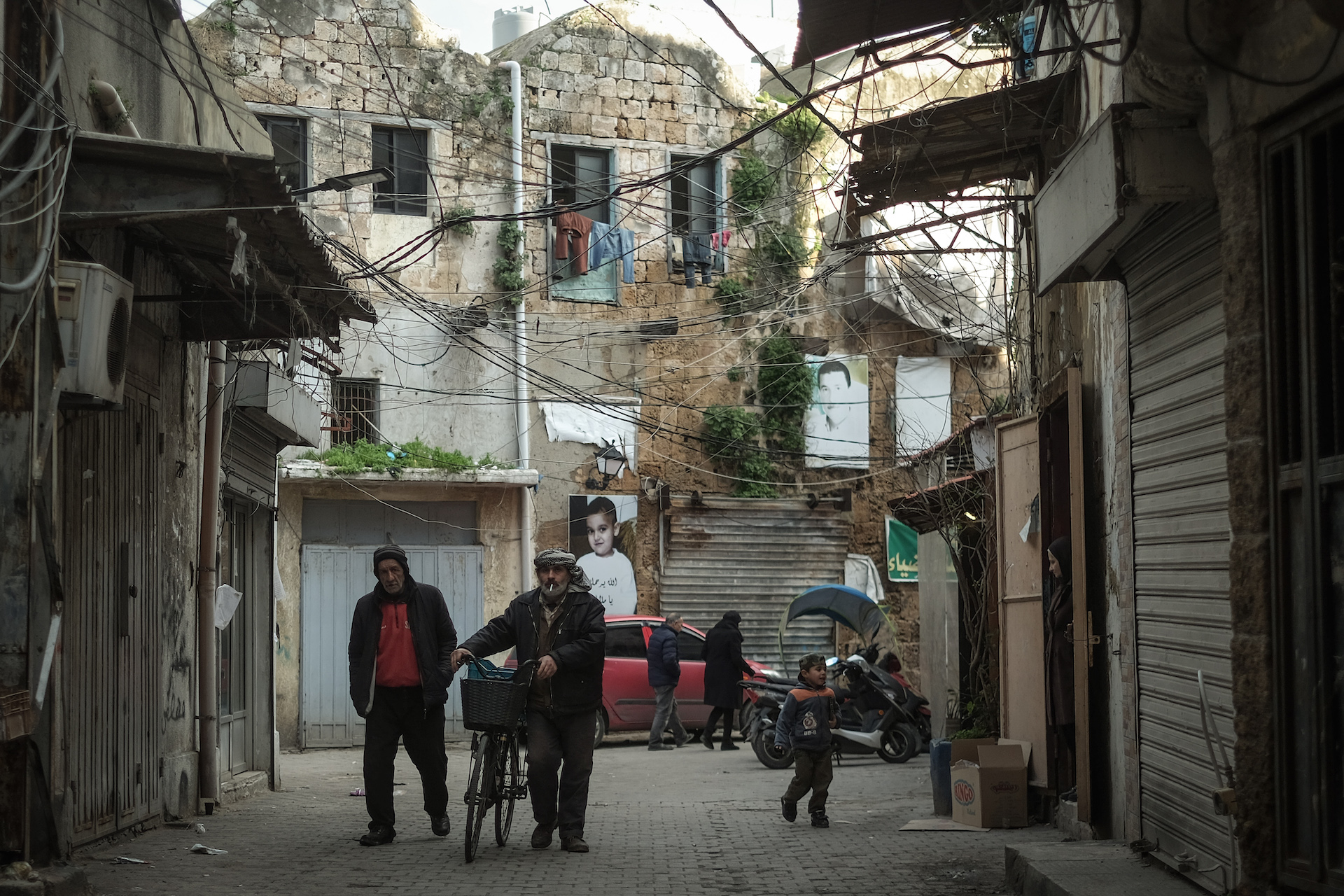 A sidestreet in Tripoli's historic Mina district. Feb. 9, 2023. (Credit: João Sousa/L'Orient Today/File photo)
A sidestreet in Tripoli's historic Mina district. Feb. 9, 2023. (Credit: João Sousa/L'Orient Today/File photo)
One year ago, when L’Orient Today visited the Hammoul household in the khan, the quake had shaken the ceiling of one of their rooms, creating a massive hole and filling the room with rainwater.
Today, it is in the exact same condition, the room still completely unusable and strewn with waterlogged clothing. They are unable to repair the ceiling with the little income Hammoul’s teenage son makes selling fish. Her husband, once a carpenter, no longer works.
Standing in the dark stone room amid the rainwater, Hammoul nevertheless says she “thanks God we have bread.”
Rabih Kabbara, an architect from the OEA in Tripoli, says he inspected “a large number of buildings” in the city after last year’s quake.
He says that approximately one in 20 buildings he personally inspected across various neighborhoods in Tripoli, including Bab al-Tabbaneh, Qibbe, and Mina, exhibits “minor risk.”
He notes that only two or three buildings that he visited in Tripoli present a major structural risk, while others impacted by the earthquake suffer fixable wall fissures.
But there are many other buildings in the city that he did not personally visit and others that likely received no inspection at all, despite structural risks. He says that’s because some architects began charging fees for safety inspections after the quake, dissuading low-income residents of Tripoli from seeking expert assistance.
Kabbara emphasizes that the structural issues plaguing many buildings in Tripoli were evident even before the earthquake.
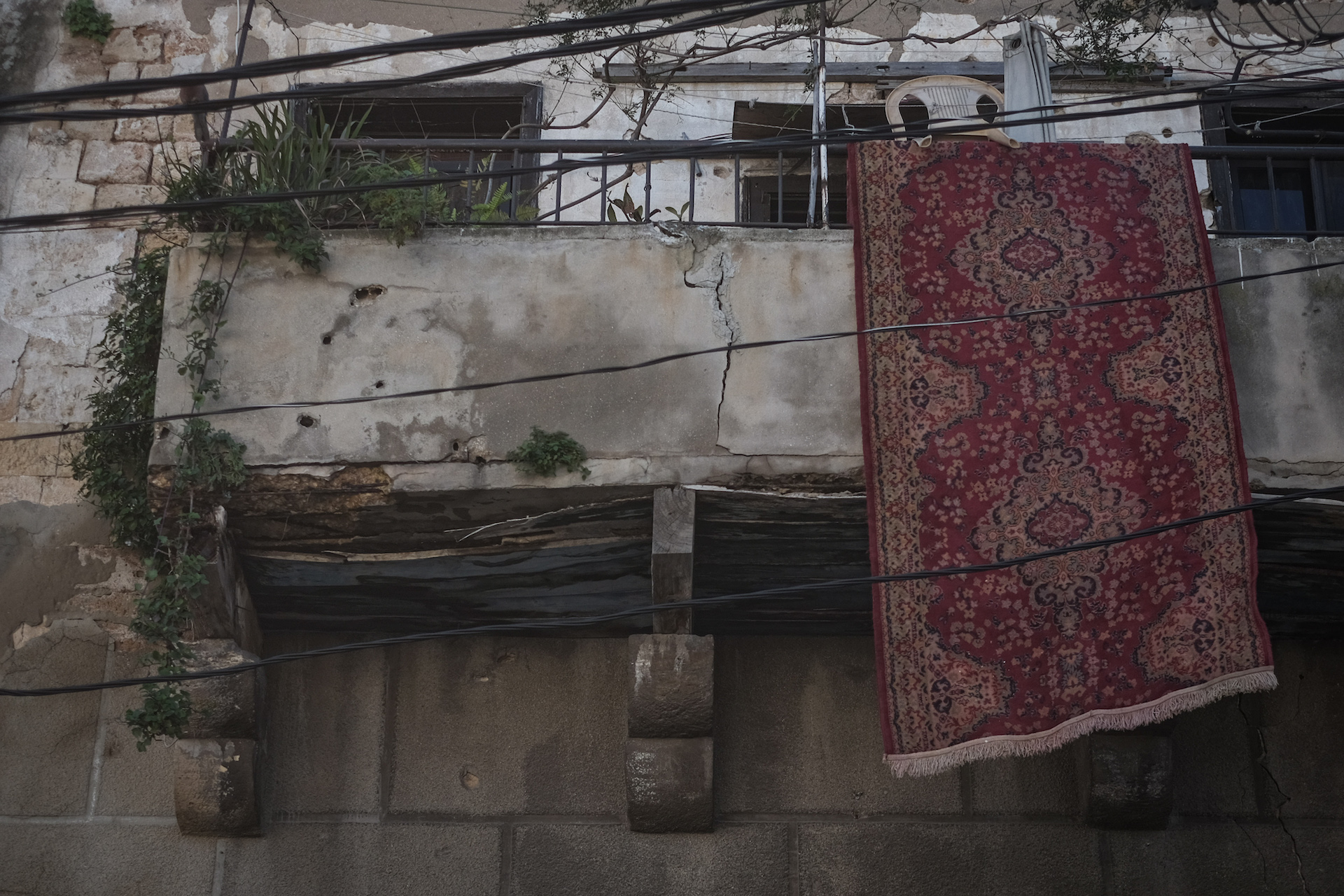 A cracked balcony in Tripoli's Mina district. Feb. 9, 2023. (Credit: João Sousa/L'Orient Today/File photo)
A cracked balcony in Tripoli's Mina district. Feb. 9, 2023. (Credit: João Sousa/L'Orient Today/File photo)
These challenges primarily stem from neglect.
The majority of these affected structures or those with pre-existing issues are privately owned, with some being rental properties, Kabbara notes.
Both renters and owners lack the financial capacity to cover the rehabilitation costs of their apartments, he says. Furthermore, renters often find themselves without the means to secure alternate housing.
The municipality of Tripoli, constrained by limited budgets, habitually advises occupants of at-risk buildings to vacate, but it lacks the authority to enforce such actions, especially as it does not provide viable alternatives, according to Kabbara. Tripoli mayor Ahmad Qamreldine was unable to answer L’Orient Today’s request for comment.
Floors shaken beneath residents’ feet
Among the high-risk buildings identified by Kabbara is the one Hanan* resides in.
Before the earthquake, saddled with medical bills due to her husband's battle with prostate cancer, Hanan leased out their original spacious apartment and rented a smaller place to help cover both her livelihood and her husband's treatments.
The earthquake left their apartment scarred, its walls adorned with ominous fissures that prompted the occupants who had been living there at the time of the quake to hastily vacate. “No one wanted to live here,” she says.
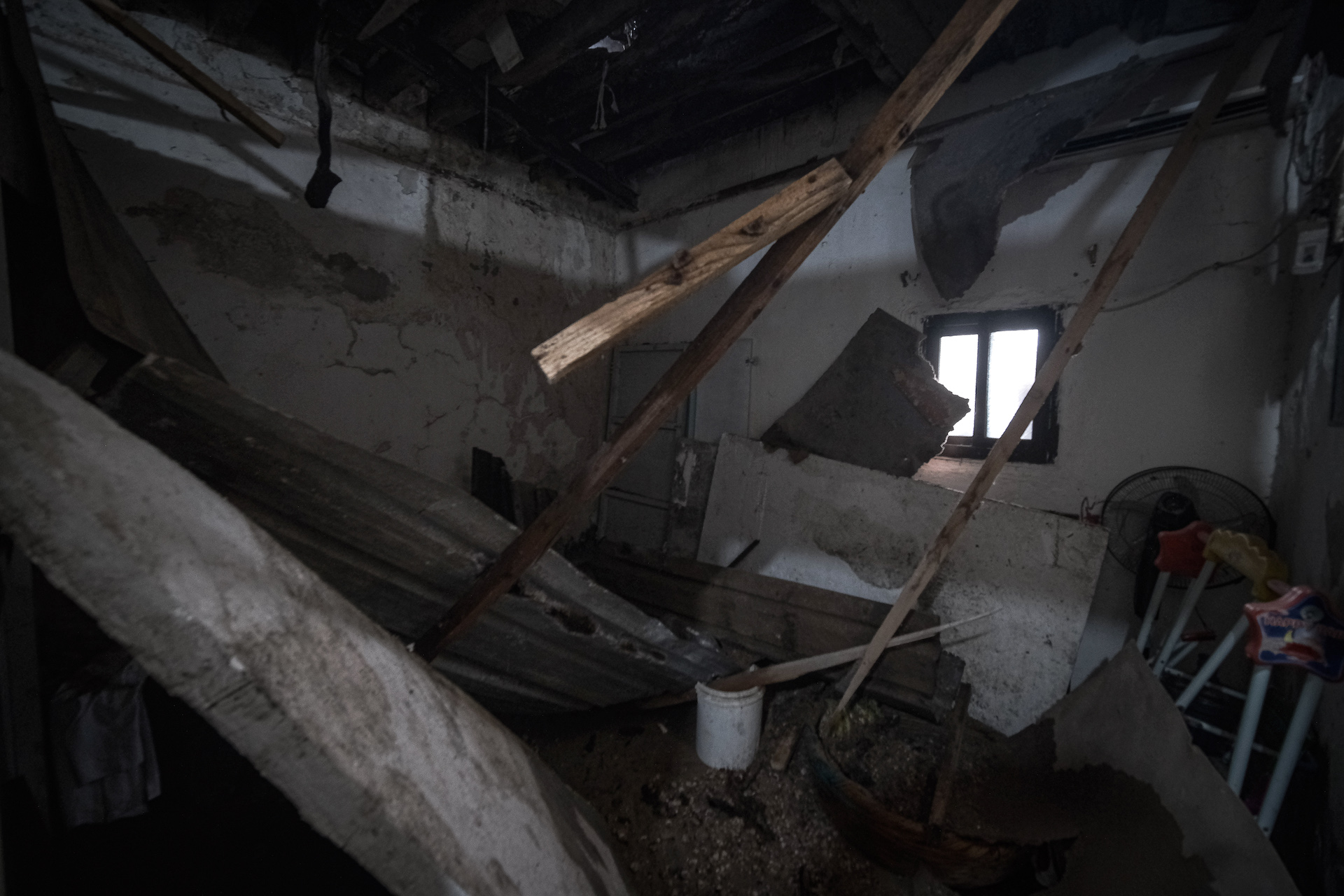 The collapsed ceiling in Dalia Hammoul's home, which is still not repaired one year after the earthquake. Feb. 9, 2023. (Credit: João Sousa/L'Orient Today/File photo)
The collapsed ceiling in Dalia Hammoul's home, which is still not repaired one year after the earthquake. Feb. 9, 2023. (Credit: João Sousa/L'Orient Today/File photo)
The absence of alternatives forced Hanan and her husband to return to the damaged apartment only two months after leaving.
Leading L’Orient Today to her bedroom, Hanan traces new fissures, which she says emerged this fall. “Here, this one above the door is new,” she says. She gestures towards a corner next to her bedroom closet. “All of this is new.”
“Of course, we are scared living here, but where can we go? We have no one and no other place to go to.”
Despite her worries, Hanan has not been following up on the building’s rehabilitation works, if any, because she cannot afford to pay for them.
Architect Kabbara also says he has not followed up on the current status of the building, which he personally inspected, or whether it has undergone the necessary rehabilitation construction work.
“If prompt action regarding high-risk buildings is not taken, we might see a serious disaster,” he warns. “If the owners who suspect structural issues with their apartments do not come forward with this information to the authorities or experts, no one can know that it is high-risk.”
No shelter from the storm
Compounding Jlaylati’s distress at his home in Bab al-Tabbaneh, recent rain showers seep through the cracks, dampening furniture and fostering the growth of mold.
Still, he says he won’t leave the home behind. “Where can we go? Who would host us?”
Jlaylati works at a chicken shop, earning a meager income of $10 per weekday and $12 per weekend workday.
“What can you buy with that money? Some tomatoes, potatoes, and bread… I cannot afford fixing anything in the house.”
“It is still better than living on the streets.”
While haggling over the price of laundry soap at a nearby shop, elderly Hind Jeha details the perilous state her apartment remains in one year after the earthquake.
She has three plastic bags in tow, filled with second-hand items she is trying to sell to secure money to feed herself and her ailing daughter.
Jeha says the state of the balconies of her apartment, in the Jabal Mohsen neighborhood, are visibly cracked. “We still go out though, but we try to be light,” Jeha giggles.
“You can see the metal [rebar] through the walls,” she says, her tone now somber.
She says she routinely picks up fragments of debris crumbling from the ceiling.
Jeha has lived in her home for 60 years, with cracks and fissures in the walls only growing. New ones emerge every once in a while.
“My daughter sleeps upside down on the bed to avoid the water seeping through the fissures,” she adds.
If another earthquake happens, Jeha figures, “the building will most probably collapse.”
* This interviewee spoke on condition of a pseudonym, saying she feared problems with her neighbors over speaking to the press about their building’s structural dangers.
